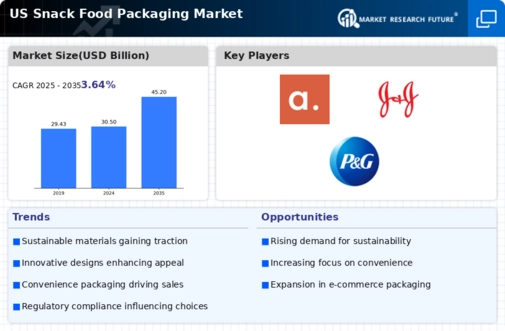Rising Health Consciousness
The increasing awareness of health and wellness among consumers is driving the snack food-packaging market. As individuals become more health-conscious, they seek snacks that align with their dietary preferences, such as low-calorie, organic, or gluten-free options. This shift necessitates packaging that clearly communicates nutritional information and ingredient transparency. In 2025, it is estimated that 60% of consumers prioritize health benefits when selecting snacks, influencing manufacturers to adopt packaging that highlights these attributes. the snack food-packaging market needs to adapt to these changing consumer preferences. by incorporating features that promote health benefits, such as resealable bags and portion control packaging, which can enhance the overall consumer experience.
Growth of On-the-Go Snacking
The rise of on-the-go lifestyles is significantly influencing the snack food-packaging market. As consumers increasingly seek convenient snack options that fit their busy schedules, packaging that facilitates portability becomes essential. In 2025, it is anticipated that the demand for single-serve packaging will increase by 30%, reflecting a shift towards convenience. This trend drives manufacturers to design packaging that is lightweight, resealable, and easy to carry. Additionally, the snack food-packaging market must adapt to various distribution channels, including vending machines and convenience stores, which require packaging that maintains product freshness and appeal. As consumer preferences evolve, the focus on on-the-go snacking is likely to shape the future of packaging design and functionality.
Technological Advancements in Packaging
Innovations in packaging technology are significantly impacting the snack food-packaging market. Developments such as smart packaging, which includes QR codes and temperature indicators, are becoming more prevalent. These technologies not only enhance the consumer experience but also improve supply chain efficiency. For instance, the integration of biodegradable materials is projected to grow by 25% in the next few years, reflecting a shift towards sustainability. Additionally, advancements in printing technology allow for more vibrant and informative designs, which can attract consumers' attention retail shelves. As these technologies evolve, they are likely to reshape the landscape of the snack food-packaging market, offering new opportunities for differentiation and brand loyalty.
Consumer Demand for Eco-Friendly Packaging
The growing consumer demand for eco-friendly packaging solutions is a pivotal driver in the snack food-packaging market. As environmental concerns rise, consumers are increasingly favoring brands that utilize sustainable materials. In 2025, it is projected that 40% of consumers will actively seek out snacks packaged in recyclable or compostable materials. This trend compels manufacturers to explore alternative packaging options, such as plant-based plastics and biodegradable films. The shift towards eco-friendly packaging not only aligns with consumer values but also enhances brand reputation. As a result, companies in the snack food-packaging market are likely to invest in research and development to create innovative, sustainable packaging solutions that meet consumer expectations.
Regulatory Compliance and Safety Standards
the snack food-packaging market faces stringent regulatory requirements and safety standards.. In the US, the Food and Drug Administration (FDA) mandates specific labeling and packaging guidelines to ensure consumer safety. Compliance with these regulations is essential for manufacturers to avoid penalties and maintain market access. As of 2025, it is estimated that 70% of companies in the snack food-packaging market are investing in compliance measures to meet these standards. This focus on regulatory adherence not only enhances consumer trust but also drives innovation in packaging materials and designs that prioritize safety and sustainability. Consequently, manufacturers are compelled to stay informed about evolving regulations to remain competitive.














Leave a Comment